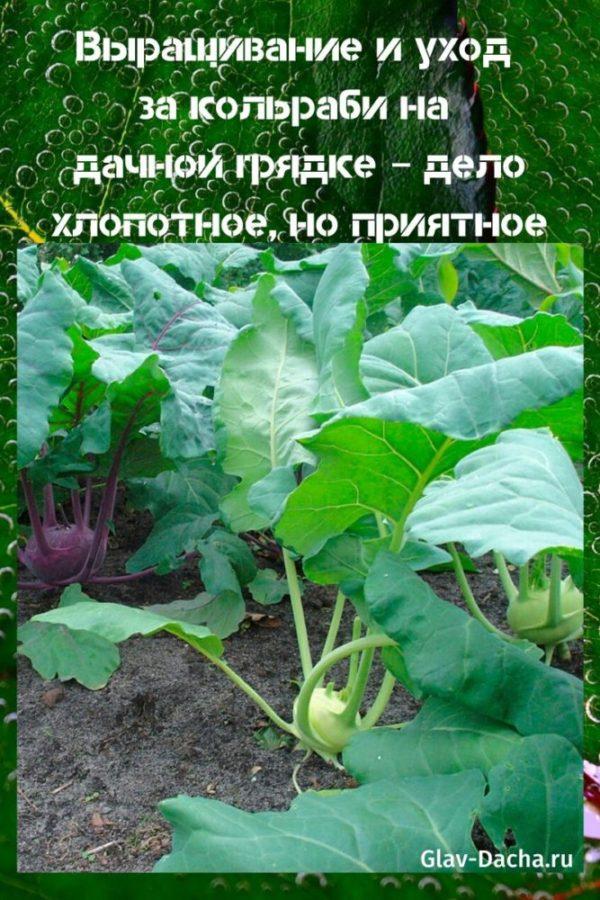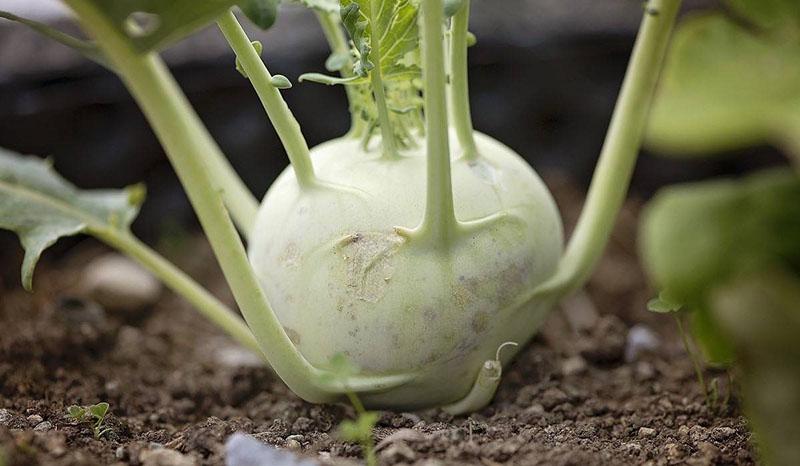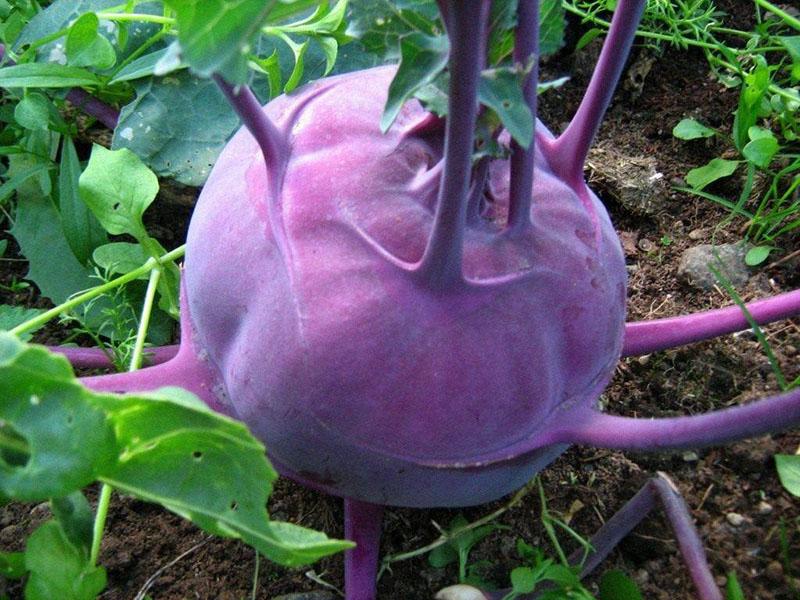Growing and caring for kohlrabi in a summer cottage is a troublesome but pleasant business
 More recently, an unusual cabbage called kohlrabi has appeared on supermarket shelves. Growing and caring for kohlrabi requires special knowledge, so only a few plant a vegetable in their summer cottage. However, in other countries, the plant has gained particular popularity. The main reason is the unique taste, chemical composition and ease of maintenance. Let's find out what this overseas fruit is. How to grow it in the garden? And also we will understand the rules of care.
More recently, an unusual cabbage called kohlrabi has appeared on supermarket shelves. Growing and caring for kohlrabi requires special knowledge, so only a few plant a vegetable in their summer cottage. However, in other countries, the plant has gained particular popularity. The main reason is the unique taste, chemical composition and ease of maintenance. Let's find out what this overseas fruit is. How to grow it in the garden? And also we will understand the rules of care.
Exotic Overseas Cabbage Outfit

 Kohlrabi is a close relative of white cabbage, although it looks more like a turnip. Its life cycle lasts 2 years. First, the culture develops a spherical stem fruit. And after the season, inflorescences and seeds appear.
Kohlrabi is a close relative of white cabbage, although it looks more like a turnip. Its life cycle lasts 2 years. First, the culture develops a spherical stem fruit. And after the season, inflorescences and seeds appear.
The plant has large leaf plates, painted in a rich green color. They are crowned with a unique stem crop. Depending on the variety, it is painted in the following colors:
- soft green;
- golden;
- white;
- crimson;
- purple.
 The mass of a ripe fruit reaches 150 g, its diameter is about 16 cm. The pulp has a sweetish taste and buttery texture. She is always white. Dense and pleasantly crispy. The root system of cabbage turnip has many branches that penetrate about 30 cm deep into the soil. The classic process of growing and caring for kohlrabi lasts about 70-80 days.
The mass of a ripe fruit reaches 150 g, its diameter is about 16 cm. The pulp has a sweetish taste and buttery texture. She is always white. Dense and pleasantly crispy. The root system of cabbage turnip has many branches that penetrate about 30 cm deep into the soil. The classic process of growing and caring for kohlrabi lasts about 70-80 days.
Most popular varieties:
- "Violetta" (the species is resistant to temperature changes);
- "Vienna" (not afraid of drought);
- "Giant" (late ripening hybrid);
- Hummingbird;
- "Kosak"
 In the northern regions, "Pikant", "Gabi", "Nezhenka" are successfully grown. The varieties with purple fruit are characterized by dense flesh. Such cabbage is resistant to pests and diseases. Retains taste for a long time. For white stems of character, tender pulp.
In the northern regions, "Pikant", "Gabi", "Nezhenka" are successfully grown. The varieties with purple fruit are characterized by dense flesh. Such cabbage is resistant to pests and diseases. Retains taste for a long time. For white stems of character, tender pulp.
If the harvest is late, kohlrabi takes on a tough texture.
Composition and nutritional value

Overseas cabbage gained its popularity due to its rich chemical composition. The foliage and pulp of the product contains:
- cellulose;
- glucose;
- vitamins A, B, C, E, PP;
- phosphorus compounds;
- potassium;
- iron.
In addition, kohlrabi produces a small amount of calories. Therefore it is ideal for dietary meals.
Cabbage turnip leaves are a wonderful addition to vegetable salads.
Traditional healers advise using kohlrabi fruits for constipation, high cholesterol, puffiness, bronchitis. What a happiness to have such a miracle in your garden!
Growing and caring for kohlrabi
 The abundance of valuable components, useful properties and piquant taste of the culture is admirable. Many summer residents are already enjoying the rich harvest. However, in order to achieve the cherished goal, it is necessary to adhere to specific agronomic rules. And as a reward to harvest 2 times. Let's try to figure out how to grow kohlrabi cabbage in the garden, taking into account the opinion of experts. The technology includes several important points.
The abundance of valuable components, useful properties and piquant taste of the culture is admirable. Many summer residents are already enjoying the rich harvest. However, in order to achieve the cherished goal, it is necessary to adhere to specific agronomic rules. And as a reward to harvest 2 times. Let's try to figure out how to grow kohlrabi cabbage in the garden, taking into account the opinion of experts. The technology includes several important points.
Suitable territory

The successful development of the culture directly depends on the chosen place for the garden. Agronomists advise paying attention to the following indicators:
- illumination;
- temperature changes;
- drafts.
Kohlrabi loves spacious open areas, where there is always an abundance of sunlight. Of course, it can also grow in shaded areas. But in such conditions, her yield decreases.
 Cabbage turnip successfully adapts to various climatic conditions. However, its development is adversely affected by the frequent temperature drop. Readings below 5 ° C accelerate seed emergence. And prolonged heat leads to lignification of the stalk. Lingering precipitation causes deep cracks, which stimulates the decay process.
Cabbage turnip successfully adapts to various climatic conditions. However, its development is adversely affected by the frequent temperature drop. Readings below 5 ° C accelerate seed emergence. And prolonged heat leads to lignification of the stalk. Lingering precipitation causes deep cracks, which stimulates the decay process.
Pay special attention to the direction of the wind. Kohlrabi does not like places where there are often drafts. It is better to plant the culture on the south side, or under the cover of outbuildings.
Soil and crop rotation
Competent cultivation and care of kohlrabi also includes the right choice  soil. Light, fertile soil with a neutral acidity index is best suited. It must have good drainage and a crumbly texture. Poor land must be enriched with humus, wood ash, peat.
soil. Light, fertile soil with a neutral acidity index is best suited. It must have good drainage and a crumbly texture. Poor land must be enriched with humus, wood ash, peat.
Agronomists do not recommend growing kohlrabi in wetlands.
For culture, the predecessors who were in the garden are of particular importance. Do not plant a plant after:
- broccoli;
- cauliflower;
- radish;
- horseradish.
Otherwise, kohlrabi will be targeted by pests that have already taken root on the site. The plant bears abundant fruit after potatoes, tomatoes, squash and carrots. Good neighbors for cabbage turnips are legumes or lettuce.
Growing cabbage turnip seedlings
 To keep kohlrabi on the table for a whole season, vegetable growers use two methods of planting a plant. It is sown directly into open ground or grown through seedlings. To obtain a quick harvest, the second method is used. Let's consider it in more detail.
To keep kohlrabi on the table for a whole season, vegetable growers use two methods of planting a plant. It is sown directly into open ground or grown through seedlings. To obtain a quick harvest, the second method is used. Let's consider it in more detail.
First of all, experts determine the timing of sowing seeds. They depend on the goal. The first batch of culture is sown in March. For the second, the beginning of May is suitable. And the third - at the end of June.
It is best to use early varieties of the crop.
 The first thing you need to grow kohlrabi cabbage in a seedling way is a spacious windowsill. There is always an abundance of sunshine and a stable temperature. Next, they select spacious containers and prepare the substrate. The easiest way to buy potting soil is from a store. But it's more economical to cook it yourself.
The first thing you need to grow kohlrabi cabbage in a seedling way is a spacious windowsill. There is always an abundance of sunshine and a stable temperature. Next, they select spacious containers and prepare the substrate. The easiest way to buy potting soil is from a store. But it's more economical to cook it yourself.
Would need:
- peat;
- sod land;
- sand.
The components are taken in the same quantity. Mix thoroughly. Disinfect with a manganese solution. After that, the containers are filled.
At the next stage, the planting material is prepared:
- carefully sort out, leaving only large specimens;
- the seeds are placed in hot water for 20 minutes;
- immersed in cold liquid for 2 minutes.
While the planting material "cools down" growth stimulator "Epin" diluted with water (according to the instructions). Using a slotted spoon, the seeds are transferred to a new solution for 12 hours. Then it is thoroughly washed under the tap and placed in the refrigerator for a day. The seeds are removed on the day of sowing in a few hours so that they dry out properly.
Seed sowing technique
 Before planting, be sure to moisten the top layer of the substrate. Using a miniature spatula or a plastic ruler, make holes about 1 cm deep. The maximum distance between the rows is 3 cm. The seeds are laid out separately every 2 cm. The crops are crushed from above with soil. Slightly compacted. It is much more convenient to sow directly into separate containers.
Before planting, be sure to moisten the top layer of the substrate. Using a miniature spatula or a plastic ruler, make holes about 1 cm deep. The maximum distance between the rows is 3 cm. The seeds are laid out separately every 2 cm. The crops are crushed from above with soil. Slightly compacted. It is much more convenient to sow directly into separate containers.
The procedure is easier to carry out with regular tweezers.
Seedling care
 After about 5 days, kohlrabi seeds germinate and greens appear.In order to slow down the growth of seedlings a little, and it does not stretch too much, the containers are transferred to a cool room. A week later, they return to their original place.
After about 5 days, kohlrabi seeds germinate and greens appear.In order to slow down the growth of seedlings a little, and it does not stretch too much, the containers are transferred to a cool room. A week later, they return to their original place.
To strengthen the seedlings, the soil is periodically fed with chemical fertilizers that contain nitrogen, potassium and phosphorus. The first time the procedure is carried out in the presence of 4 real leaves. The last time the drugs are applied immediately before planting on the beds. Water the ground as the top layer dries.
 The raised seedlings need a sufficient amount of light and air. Therefore, it is important to understand when is the best time to dive a kohlrabi? Agronomists advise to carry out the procedure after the appearance of the first leaf. Before transplanting, the soil is moistened abundantly. Then the seedlings are carefully transferred into separate containers with a small clod of earth. The top layer is compacted and placed in a room where the temperature is not higher than 20 ° C.
The raised seedlings need a sufficient amount of light and air. Therefore, it is important to understand when is the best time to dive a kohlrabi? Agronomists advise to carry out the procedure after the appearance of the first leaf. Before transplanting, the soil is moistened abundantly. Then the seedlings are carefully transferred into separate containers with a small clod of earth. The top layer is compacted and placed in a room where the temperature is not higher than 20 ° C.
In order not to injure the crop with a pick, it is advisable to sow the seeds in containers with small cells.
Gardening scheme and competent care
 For 14 days, before transferring the seedlings to open ground, they are diligently hardened. In the room where the containers are, they open the window every day. When it's warm and sunny outside, they are taken out into the fresh air.
For 14 days, before transferring the seedlings to open ground, they are diligently hardened. In the room where the containers are, they open the window every day. When it's warm and sunny outside, they are taken out into the fresh air.
The process of planting kohlrabi in open ground and caring for it consists of simple steps:
- dig a hole in the prepared area;
- pour 1 glass of wood ash onto the bottom;
- add urea (1 teaspoon) and superphosphate (2 tablespoons);
- pour in water to form a thick mass.
 Carefully remove the seedlings from the container and place them in the hole, trying not to injure the roots. Top covered with dry soil. The top layer is tamped by hand. For the successful development of the plant, the garden bed is regularly moistened with a spray bottle. Weed aisles, removing weeds. If necessary, feed the soil.
Carefully remove the seedlings from the container and place them in the hole, trying not to injure the roots. Top covered with dry soil. The top layer is tamped by hand. For the successful development of the plant, the garden bed is regularly moistened with a spray bottle. Weed aisles, removing weeds. If necessary, feed the soil.
We looked at the advice of agronomists on how to choose the right site for a crop. We learned the technology of seed preparation. We learned when to plant kohlrabi in open ground in order to get a double share of the crop. We understand the secrets of proper care. Now it's not scary to start an exotic fruit in the garden, originally from the Mediterranean.